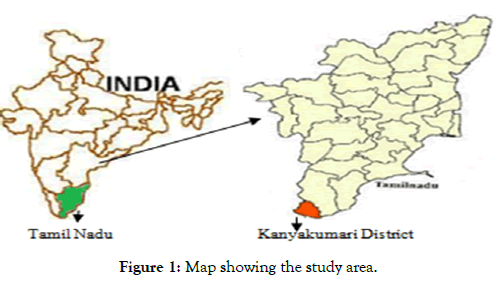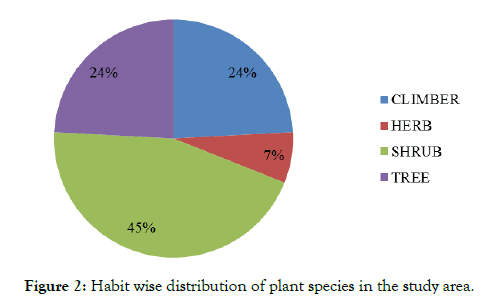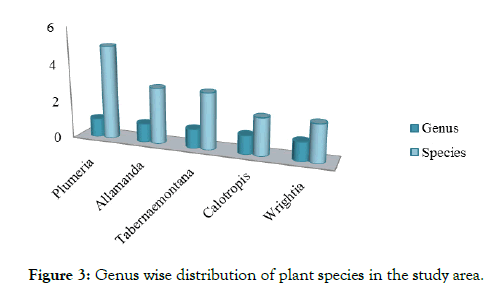Medicinal & Aromatic Plants
Open Access
ISSN: 2167-0412
ISSN: 2167-0412
Research Article - (2021)Volume 10, Issue 2
The present study highlights the diversity study of ornamental flowering plants in Apocynaceae family, which are documented from Kanyakumari District, Tamil Nadu, India. We have identified 29 species belonging to 19 genera is used as decorative potentialities, of these flora are highlighted due to its appealing addiction and accurate searching plants. The present study suggested that this work will help the researchers and people who are interested in ornamental plants.
Apocynaceae; Ornamental; Kanyakumari district
Angiosperms, the dominating group of flowering plants in the present world are further expanding with the unending addition of newer taxa, one of the reasons possibly being the critical evaluation and exploration of the existing biota. India is blessed by nature with one of the richest floras on the earth and is considered as the center of origin of a number of wild as well as cultivated plants [1].
Nevertheless, Apocynaceae is considered as one of the largest families of gamopetalae. This family belongs to the order Gentianales. The family Apocynaceae is also known as Dogbane or Oleander family. It includes trees, shrubs, herbs, climbers usually with milky latex. Since the classification of Schumann [2], the Apocynaceae have traditionally been divided into two subfamilies, the Plumerioideae and the Apocynoideae. Recently, based on molecular data, classification of Apocynaceae has passed through good sized revisions. According to the Angiosperm Phylogeny Group III [3] the family Asclepiadaceae is now included in the Apocynaceae. This revision is also updated in Angiosperm Phylogeny Group IV (APGIV 2016). The family, as currently recognized, includes some 1500 species divided in about 424 genera and five subfamilies: Apocynoideae, Rauvolfioideae, Asclepiadoideae, Periplocoideae, and Secamonoideae [4].
Ornamental plants of Apocynaceae with various color blooms (Catharanthus roseus, Nerium oleander) are cultivated throughout India and other countries. One such taxon, Thevetia peruviana with yellow, orange (apricot or peach) and white blooms are used to ornament the Indian gardens. Ornamentals are an abundant group of plants, including both native and alien species, which are extremely variable in terms of their life form and cultivation needs. They form an important component of the human environment, because they are grown in a broad spectrum of habitats such as gardens, public spaces (e.g. town squares or cemeteries), indoors (as houseplants), open land (e.g. in belts along roads), floriculture plantations and specialist garden collections [5].
Ornamental plants are grown for display purposes, rather than functional ones. While some plants are both ornamental and functional, people usually use the term ornamental plants to refer to plants which have no value beyond being attractive, although many people feel that this is value enough. Ornamental plants are the keystone of ornamental gardening, and they come in a range of shapes, sizes and colors suitable to a broad array of climates, landscapes, and gardening needs. Ornamental plants are grown usually for the purpose of beauty for their fascinating foliage, flowers and their pleasant smell [6]. The aim of the present research was to explore and assess the ornamental plant diversity of Apocynaceae family in Kanyakumari District.
Study area
The research employed a survey method, with purposive sampling in the Kanyakumari District, Tamil Nadu, India. Kanyakumari District, the southernmost tip of Indian Peninsula, is divided into four taluks namely: Agastheeswaram, Kalkulam, Vilavancode and Thovalai. The Kanyakumari District has mainly four types of lands i.e., Kurunji (Hilly tract), Mullai (Forest), Marutham (Agricultural land) and Neidal (Sea-shore). The Northern and Western part of the district are hilly tracts and forests. In the South-Eastern and middle parts, the districts have agricultural and traditionally, known as the Nanjil Nadu (the Land of Plough). The Southern border of the district has a long sea-shore.
Location of the Kanyakumari District is bounded between 77°05l and 77°35l of the Eastern longitude and 8°05l and 8°35l of the Northern latitude. The soil is red, varying in the quantity of ferruginous element. The climate of Kanyakumari District is warm and humid. Summer extends from March to May, which is followed by southwest monsoon from June to September. October and November are post-monsoon or retreating monsoon season with frequent thunderstorms. The northeast monsoon season extending from December to February is generally rainy and the other months are bright. The mean annual rainfall was 167.64 mm and varied from 70 mm (minimum during February) to 442 mm (maximum-October).
Floristic survey
The periodical trips were undertaken to the different parts of the study area at weekly intervals between October 2019 and March 2020. The identification of plant species was done using taxonomic literatures and with the help of experts. Specimens of ornamental plants were collected and identified taxonomically by using the regional and flora [7-9]. The plant species are enumerated and arranged as per Angiosperm Phylogeny Group IV Classification [10]. The nomenclature of the species was checked using IPNI [11].
In the study, the plant species recorded have been arranged alphabetically for each species the binomial name is followed by the common name; life-forms, propagation, flowering and fruiting periods are recorded. Photographs were taken in the appropriate periods while visiting the gardens. A brief description of the plant was also recorded in the field. Plant materials collected were pressed using plant presses and allowed to take a form of flat sheet and were put in a drier to facilitate drying using blotters and newspapers to absorb the moisture associated with the specimens and corrugated card board that facilitates ventilation to remove moisture. Wellpreserved specimens with voucher numbers were deposited in the Herbarium in the Department of Botany and Research Centre, Nesamony Memorial Christian College, Marthandam, Tamil Nadu, India. Geographical maps are provided for the location of Kanyakumari District, Tamil Nadu, India (Figure 1).

Figure 1: Map showing the study area.
The present survey resulted in the documentation of 29 ornamental plant species in the Apocynaceae family (Table 1). For all the enumerated plant species, information such as botanical name, common name, habit, propagation and flowering fruiting were provided.
| S. No | Botanical Name | Common Name | Habit | Propagation | Flowering & Fruiting |
|---|---|---|---|---|---|
| 1 | Adenium obesum (Forssk.) Roem. & Schult. | Desert Rose | Shrub | Seed and Vegetative | Throughout the year |
| 2 | Allamanda blanchetii A.DC. | Purple Allamanda | Climber | Vegetative | Throughout the year |
| 3 | Allamanda cathartica L. | Yellow Allamanda | Climber | Seed and Vegetative | Throughout the year |
| 4 | Allamanda schottii Pohl | Bush Allamanda | Shrub | Vegetative | Throughout the year |
| 5 | Alstonia scholaris (L.) R. Br. | Devil tree | Tree | Seed | September â?? January |
| 6 | Asclepias curassavica L. | Scarlet milkweed | Herb | Seed and Vegetative | June -October |
| 7 | Calotropis gigantea (L.) Dryand. | Crown flower | Shrub | Seed and Vegetative | Throughout the year |
| 8 | Calotropis procera (Aiton) Dryand. | Sodom apple | Shrub | Seed and Vegetative | Throughout the year |
| 9 | Carissa carandas L. | Karanda | Shrub | Seed and Vegetative | March -September |
| 10 | Cascabela thevetia (L.) Lippold | Yellow Oleander | Shrub | Seed and Vegetative | Throughout the year |
| 11 | Catharanthus roseus (L.) G.Don | Periwinkle | Herb | Seed | Throughout the year |
| 12 | Cryptostegia grandiflora Roxb. ex R.Br. | Rubber vine | Climber | Seed and Vegetative | March â?? September |
| 13 | Dregea volubilis (L.f.) Benth. ex Hook.f. | _ | Climber | Seed | March -July |
| 14 | Kopsia fruticosa (Roxb.) A.DC. | Shrub vinca | Shrub | Vegetative | Throughout the year |
| 15 | Mandevilla laxa (Ruiz & Pav.) Woodson | Chilean jasmine | Climber | Vegetative | January -June |
| 16 | Nerium oleander L. | Oleander | Shrub | Vegetative | April -October |
| 17 | Pentalinon luteum (L.) B.F.Hansen & Wunderlin | Wild Allamanda | Climber | Seed and Vegetative | June -October |
| 18 | Pergularia daemia (Forssk.) Chiov. | Pergularia | Climber | Seed | November â?? March |
| 19 | Plumeria alba L. | Pagoda tree | Tree | Seed and Vegetative | May -November |
| 20 | Plumeria obtusa L. | White Frangipani | Tree | Vegetative | July -August |
| 21 | Plumeria pudica Jacq. | Bridal Bouquet | Shrub | Vegetative | Throughout the year |
| 22 | Plumeria rubra I X p subsessilis A. DC. | Frangipani | Tree | Seed and Vegetative | Throughout the year |
| 23 | Plumeria rubra L. | Frangipani | Tree | Seed and Vegetative | January -June |
| 24 | Rauvolfia tetraphylla L. | Devil-pepper | Shrub | Seed | Throughout the year |
| 25 | Tabernaemontana alternifolia L. | Nag kuda | Tree | Vegetative | April -October |
| 26 | Tabernaemontana divaricata (L.) R.Br. ex Roem. & Schult. | Wax-flower plant | Shrub | Vegetative | August -December |
| 27 | Tabernaemontana rostrata Wall. | _ | Shrub | Seed | Throughout the year |
| 28 | Wrightia antidysenterica (L.) R.Br. | Arctic snow | Shrub | Seed | October -June |
| 29 | Wrightia tinctoria R.Br. | Indrajav | Tree | Seed | March -November |
Table 1: List of Apocynaceaen ornamental plant species recorded from Kanyakumari District.
Taxonomically, a total of 29 plant species belonging to 19 genera were recorded. Of these 7 (24%) were trees, 13 (45%) were shrubs, 7 (24%) were climbers/creepers and 2 (7%) were herbs (Figure 2). Dominant genera from the present study are Plumeria genus having 5 species, Allamanda and Tabernaemontana 3 species each, Calotropis and Wrightia having 2 species each, 14 genera were monospecific (Figure 3).

Figure 2: Habit wise distribution of plant species in the study area.

Figure 3: Genus wise distribution of plant species in the study area.
Some of the most striking Apocynaceae ornamental plant species of the Kanyakumari District includes the Allamanda cathartica, Catharanthus roseus, Nerium oleander, Plumeria rubra and Tabernaemontana divaricata. These ornamental plants also allow growing over walls, buildings as well as fences, this will bring more beauty and attractive look. The flowers of these members possessing various colors to attract people those who are interested in gardening. Such people also prefer these species for indoor as well as outdoor gardening. Among the attractive flowers, white color is dominant with 13 species, followed by Pink with 5 species, Purple and yellow color 4 species each, pale-green color have 2 species and Red have single species.
Based on the flowering session of selected ornamental plants, during 12 species are bloomed in the whole year, summer 8 species, spring 5 species, wintry weather 3 species and autumn single species. The plants bearing attractive tiny flowers for gardening in urban areas, inside houses, offices, banks, hospitals, hotels and other buildings with ornamental plants have become very popular due to lack of open space. Cultivation of these species may be beneficial, both commercially and to help conserve rare, vulnerable, endangered endemic plant species. Ornamental plants play an important role in environmental planning of urban and rural areas for abatement of pollution, social and rural forestry, wasteland development, afforestation, and landscaping of outdoor and indoor spaces. Landscape gardening and bio-aesthetic planning is a recent trend to establish eco-friendly human habitats.
Ornamental plants constitute an important source of alien and potentially invasive species, but also include a substantial part of native flora and consist of taxa that occur both in the wild and in cultivation. Among the 29 ornamental plants, 18 taxa (62%) were alien and 11 (38%) were native. Most alien ornamentals are native to Brazil, Africa, China, Sri Lanka and America.
Based on the boom forms, the recorded ornamental plant life are all perennials, based on propagation technique the recorded species are seed and vegetative kind of propagation method having 12 species, vegetative approach having 9 species, propagated by way of seeds 8 species. Fruit types of the recorded plants are follicle type of fruit highly dominated having 22 plant species and followed by capsules and drupe having 3 species each and berry having single species.
The total numbers of ornamental plants of Apocynaceae family recorded from the study area of the Kanyakumari District was greater than the number of species reported from the other authors from Kanyakumari District. Thus Kensa et al. [12] reported 3 species in Apocynacean members from the Campus of Bishop’s House, Nagercoil, Kanyakumari District. Suba et al. [13] reported 13 species in Tribal Homegardens of Kanyakumari Wildlife Sanctuary. Sukumaran & Parthiban [14] reported 11 species from Udayagiri fort, Kanyakumari District. Neelamegam et al. [15] reported 5 species from rural and urban areas in Kanyakumari District. Neelamegam et al. [16] reported 6 species from Swamithoppe, Kanyakumari District. Parthiban et al. [17] reported 14 species from St. Hindu College Campus Kanyakumari District. Neelamegam et al. [18] reported 4 species from Kanyakumari District. Sukumaran & Jeeva [19] reported 19 species in Nesamony Memorial Christian College, Marthandam, Kanyakumari District. Kensa [20] reported 4 species from Kattathurai Panchayath, Kanyakumari District. Kensa et al. [21] reported 5 species from Veerani Aloor, Kanyakumari District. Rejitha & Brintha [22] reported 12 species from Kirathoor Village, Kanyakumari District.
Conservation of natural resources is a matter of vital interest to man from ancient time India is playing an important role in the conservation of biological diversity and sustainable development through its own biological diversity act and rules. The biodiversity has become such an important challenge to the whole world that it has invented attention from various disciplines, people as well as all quarters of the world. There is a strong need to conserve over exploited species due to large scale of their uses and collection from natural habitats.
The present study highlights the ornamental value of some selected species of Apocynacean members of the study area. These families are widely distributed and also the dominant over the study area. Besides these, they are also having some medico-potentialities to cure different ailments. The ornamental potentiality is highlighted due to its attractive habit and good looking flowers. There is a lot of significance in recent years for the ornamental species in the utilization of various kinds and in the income generation among poor also in the export market of India. The domestication of many wild plants in ornamental point of view is also an ex-situ method conservation approach for conserving the natural resources. The present observation also emphasizes the need for the conservation of natural resources for the existence of current and future generations.
The authors wish to thank Manonmanium Sundaranar University, Abishekapatti, Tirunelveli 627 012, Tamil Nadu, India.
Citation: Rejitha S, Uma Devi S (2021) Ornamental Plant Diversity of the Family Apocynaceae in Kanyakumari District, Tamil Nadu, India. Med Aromat Plants (Los Angeles) 10: 369.
Received: 01-Feb-2021 Accepted: 15-Feb-2021 Published: 22-Feb-2021 , DOI: 10.35248/2167-0412.21.10.369
Copyright: © 2021 Rejitha S, et al. This is an open-access article distributed under the terms of the Creative Commons Attribution License, which permits unrestricted use, distribution, and reproduction in any medium, provided the original author and source are credited.